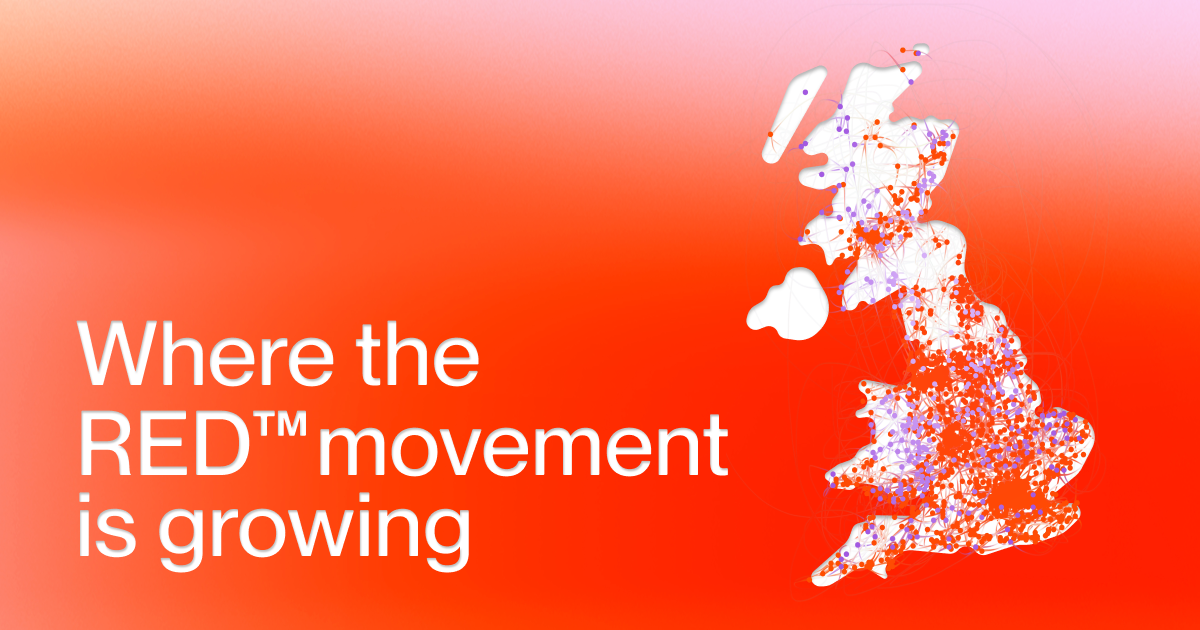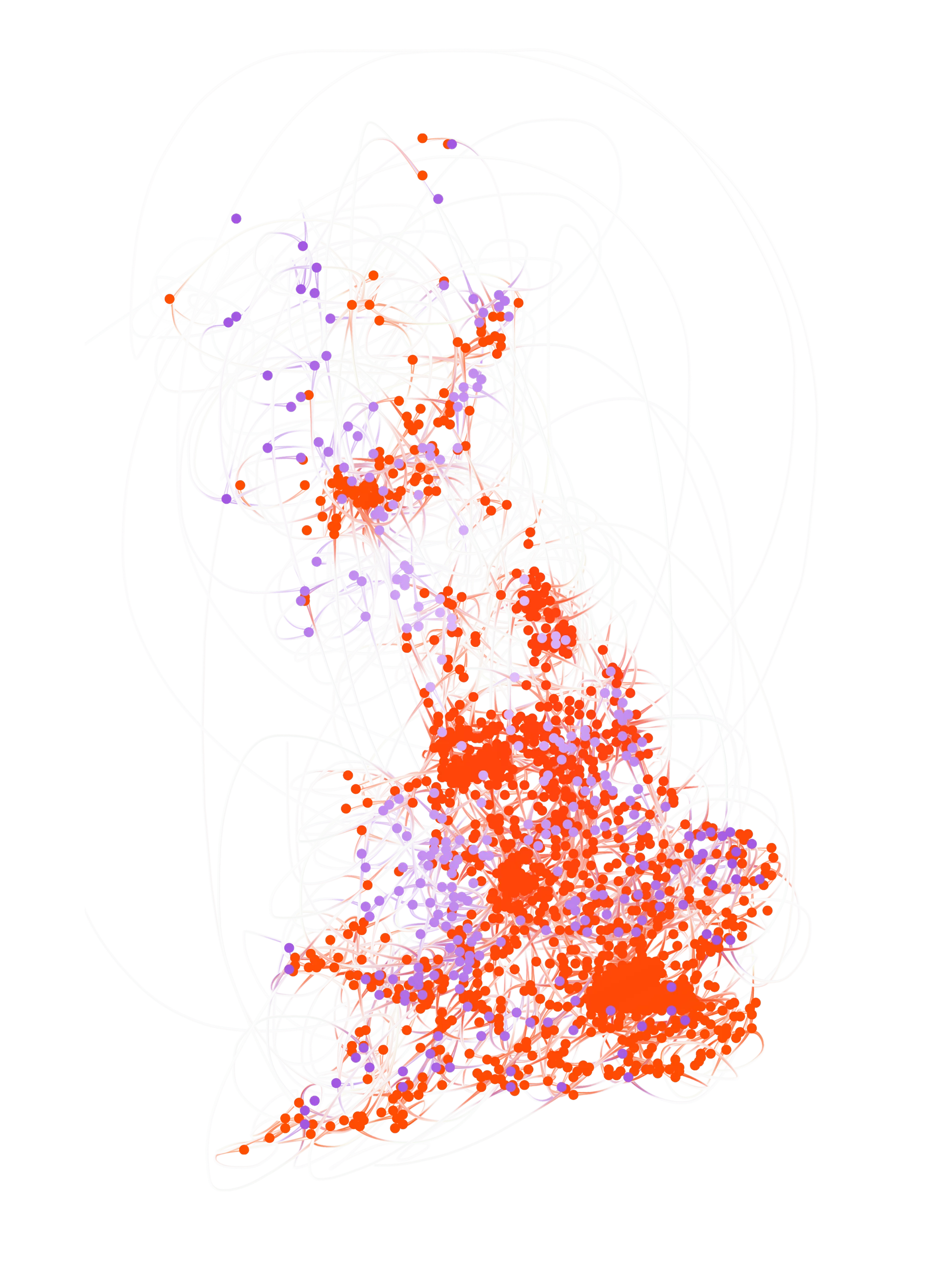Power in every postcode: The community behind the RED™ map
The RED™ map now features hundreds of live connections, each one a site that’s either generating power or buying it directly through RED™. Together, they form a growing web of businesses and renewable generators reshaping how energy flows across the UK.

For decades, energy has been controlled by a handful of suppliers, who trade through opaque systems that confuse more than they clarify. Prices rise, bills fluctuate, and most businesses never know what they’re really paying for, or where their money goes.
But a growing number of people are choosing a different route. A route built on local power, direct relationships, and full transparency. That choice is visible on the RED™ map, showing a decentralised network of businesses and generators doing energy differently.
 Each dot represents a decision to move away from outdated contracts, unclear costs, and an energy system built on volatility. Red are the businesses. Purple are the generators. Together, they're moving toward something better: energy that’s local, transparent, and fair for everyone.
Each dot represents a decision to move away from outdated contracts, unclear costs, and an energy system built on volatility. Red are the businesses. Purple are the generators. Together, they're moving toward something better: energy that’s local, transparent, and fair for everyone.
This shift starts with people. That’s never been more visible than it is now.
The RED™ map reveals where the movement is growing, who’s leading the charge, and why it matters. The people on this map are changing the energy system from the ground up, from restaurants to sports facilities, schools to manufacturers, anaerobic digesters to neighbourhood shops and city staples.
Where the RED™ movement is growing fastest
The RED™ map now features hundreds of live connections, each one a site that’s either generating power or buying it directly through RED™. Together, they form a growing web of businesses and renewable generators reshaping how energy flows across the UK and who benefits from it. That shift delivers real, measurable outcomes: cheaper power for businesses, increased revenue for generators, and greater transparency for everyone involved.
The South East leads by volume, with 25% of all active sites, a quarter of all RED™ locations nationwide. It’s also the most business-heavy region, with 24% of sites purchasing energy directly from UK generators. It’s one of the clearest examples of how strong buyer demand is for clearer pricing and renewables.
Further north, Yorkshire and the Humber and the West Midlands follow closely behind, with 17% and 13% of sites respectively. Both show steady growth across industries like manufacturing, logistics, and multi-site retail. It’s direct proof that RED™ is scaling across critical sectors of the economy.
And then there’s Scotland, home to 8% of all RED™ sites, but punching far above its weight in generation. Nearly 30% of Scottish sites are generators, making it the most generation-heavy region on the map. It’s a signal that local producers, from wind farms to AD plants, are finding new routes to market and earning fairer returns.
We’re seeing record uptake in regions where businesses have long been squeezed by rising costs and vague contracts. And across sectors, from retail to renewables, one thing is becoming increasingly clear: the growth of RED™ proves that transparency is becoming the new normal.
Businesses are choosing control over confusion, and it’s transforming how energy is bought and sold in the UK.
This isn’t just market data. It’s momentum. It’s the clearest signal yet that the energy transition is being driven not by institutions, but by the communities and companies building the system back better. It’s happening one site, one region, one decision at a time.
Voices from the map: Real businesses, real change
Behind every dot on the RED™ map is a story of a business or generator making a conscious choice to do energy differently.
Here are just a few of the people bringing the movement to life.
BOXPARK
Boxpark is a space built for people, and now, it’s powered by the same principle. Their venues have become cultural landmarks, from Shoreditch to Wembley, known for bold design, local food, and a focus on community. That same ethos now drives their energy choices.
In 2025, BOXPARK joined RED™, running three of its flagship sites on power purchased directly from UK renewable generators. For Senior Estates and Contracts Manager Michael Murrant, the decision wasn’t just about savings or sustainability. It was about backing a better system.
“With tem, we’re not just buying energy — we’re fuelling a movement for a better future,” he says. “More of the money we pay each month goes directly to the people producing clean UK power. That’s something we can stand behind.”
Gold
Across town in Notting Hill, Gold has become a local favourite, a restaurant known for produce-led cooking and relaxed atmosphere. But behind the scenes, energy bills were unpredictable and opaque. That changed when they switched to RED™.
“We were constantly trying to budget around fluctuating bills with no real transparency,” says the team. “It felt like we were paying more than we should — but had no way to challenge it.”
Now, they’ve gained full visibility into what they’re paying for and where their power comes from, along with savings they’ve reinvested back into the business.
“With energy sorted, we can focus on building the Gold brand and serving high-quality dishes to our customers.”
Duranta Energy
In Teesside, Duranta Energy is proving that renewable power can come from unexpected places. At their anaerobic digestion facility, waste from local supermarkets, councils, and food producers is transformed into renewable electricity, biomethane, and low-carbon heat.
The site processes over 120,000 tonnes of waste each year, but for years, much of the value they created was lost in the system. That changed in 2024, when they began selling their power through RED™.
“By selling our power through tem, more of the money stays with us — and we use that to cut more carbon, invest in the site, and build a fairer energy future.”
Elsewhere on the map, you’ll find:
Manufacturers in Yorkshire choosing RED™ to stabilise long-term production costs.
Community sports clubs in the Midlands supporting local wind generation.
Schools and universities across the East of England matching their values with their energy.
Agricultural sites in Wales earning more for what they generate, while reducing waste.
The network is growing, and so is the diversity of those driving it.
Why this movement matters
Every dot on this map is a rejection of business-as-usual energy. And taken together, they signal that the energy transition is already underway, and it’s being led by people.
It’s also proof that small and mid-sized generators, often overlooked in the wholesale market, now have a clear, fairer route to buyers. And as more sites connect, those benefits compound: more choice, more savings, more income staying in local communities.
What’s next
We’ve seen RED™ grow from a bold idea into a living, breathing network of over 3,000 UK sites. But this is only the beginning.
In the coming months, we’ll expand into new regions, onboard more sectors, and continue strengthening the links between generation and demand. We’ll support more Exempt Supply and P442-aligned projects. And we’ll keep building the infrastructure that makes local, transparent energy the norm.
Are you on the map yet?
If you’re generating power or simply want to know where yours comes from, RED™ helps you plug into something bigger.
A community. A movement. A better way forward.
If you’re ready for that, let’s talk.
